A good collaboration can be electrifying. Bangarra Dance Theatre’s latest double bill,Horizon– featuring their first international collaboration with Maori choreographer Moss Te Ururangi Patterson – is full voltage.
Patterson’s choreography is one half ofThe Light Insideco-created with Bangarra alumni Deborah Brown. Artistic Director Frances Rings co-commissioned the pair,so the resulting work would be a “conversation”.
“There are two parts to the story:the duality in the way that we tell our work and see our stories. There’s male/female,saltwater/freshwater,past/present.”
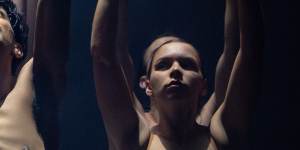
The two halves of The Light Inside are ultimately complementary.Daniel Boud
The two halves ofThe Light Insideare ultimately complementary,with a unifying through-line of venerating the sacred maternal and feminine,and water (Brown’s ancestral lines tie to the Torres Strait,and Patterson’s to Lake Taupo and the Ngati Tuwharetoa tribe).
Brown’s section,Gur/ Abad/ Salt Water,opens like an ethereal painting,with the dancers moving across a mirrored stage as if suspended on water. The movement ranges from the soft languor of dancers evoking pearl shell and coral to a climax where dancers leap and spin with lightning attack and a pointed,almost predatory,sense of direction – guaranteed to get your pulse racing. This exciting spectrum of dance is even more remarkable since Brown choreographed remotely,video-linking to the Bangarra studios so she could also act as carer for her elderly parents.
Patterson’s half,Wai Maori/ Fresh Water,will be revelatory for Australian arts audiences yet to see contemporary Maori dance. Many will have rugby’s All Blacks as a reference point for thehaka (Maori traditional dance),thinking of it as primarily warlike. But this is only a sliver of thehaka’s deeper history,meaning,and expressive scope,which Patterson explores. The Bangarra dancers are remarkable in this new form,channelling the breath,athleticism,focus and attack that give Maori dance its power.
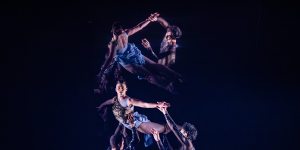
Horizon is a feast of cultural richness and groundbreaking innovation.Daniel Boud
Horizonalso comprisesKulkaby another beloved Bangarra alumni,Sani Townson of the People of Saibai Island in the Torres Strait. Townson demonstrates exceptional taste and control –Kulkapossesses a balance where movement is dynamic and complex without losing its unifying sense of joy and spontaneity. Special highlights include the use of mirrors and animations,which,although occasionally distracting,add interest,and a luminous dance evoking theSaybay Koedal(crocodile).
Ultimately,Horizonis a feast of cultural richness and groundbreaking innovation. It’s one of the best things on Australian dance stages this year.
Kirill Gerstein,Musica Viva
City Recital Hall
June 17
Reviewed by PETER McCALLUM
★★★★
Kirill Gerstein’s recital for Musica Viva revealed a pianist of commanding accomplishment,inward focus and great eloquence. He began the first half with a performance of Chopin’sPolonaise-Fantaisie in A flat major,Opus 61,that was subdued and personal,putting aside unwanted drama or portentousness as though deep in thought. When the characteristic polonaise rhythm arrived,it was articulated with precision and buoyant clarity.
This was a polonaise remembered in a dream,with dance-like fragments drifting through like phantoms populating an inner world. By contrast the polonaise at the end of the first half,Liszt’s Polonaise in E major,was wide awake,glittering with brilliance and light filigree.
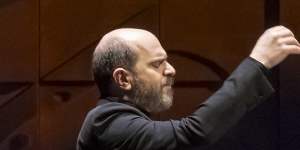
Kirill Gerstein is a pianist of commanding accomplishment and great eloquence.James Grant
Again,Gerstein secured the work’s continuity with an embodied sense of rhythm and natural sway. In between,the focus was on French music. Before playing Gabriel Faure’s sparely beautiful final Nocturne No. 13 in B minor,Opus 119,Gerstein presented a meditation,Apres Faureby jazz pianist and composer Brad Mehldau,commemorating the centenary of the older composer’s death.
Mehldau’s piece begins with the oscillating pattern that concludes Faure’s Nocturne,and recalled its ideas with reverent thoughtfulness. In Faure’s Nocturne itself,Gerstein again mixed pensiveness with clarity as though revealing its mysteries with tender care.
Faure’s younger compatriot Francis Poulenc once referred to himself as “Janus-Poulenc” to capture the incongruity of his riotous irreverence and introspective spirituality. In the first of hisThree Intermezzi,Gerstein crisply hinted at the former while the last two moved toward pensiveness and lassitude.
The second half was also framed by thoughtful Chopin,his Fantaisie in F minor,Opus 49,and music by one of his contemporaries,in this case Robert Schumann’sCarnival of Vienna,Opus 26. In between came Liza Lim’sTranscendental Etude,its title a nod to Liszt.
Lim’s music often explores the underbelly of the tonal world of a particular instrument by finding new sounds through non-standard playing techniques,but in this work she yielded to Romantic pianistic gestures,albeit haltingly. Schumann’sCarnival of Vienna is a series of scenes that seem related only by the wanderings of the composer’s imagination and throughout,Gerstein again revealed his capacity to capture the essence of a musical phrase by inhabiting its natural rhythmic gait while navigating its virtuosity with insouciant brilliance.
Watershed:The Death of Dr Duncan
Opera Australia
Joan Sutherland Theatre,Sydney Opera House
June 14
Reviewed by PETER McCALLUM
★★★
Watershed tells the vital story of how the senseless murder of Dr Ian Duncan in the River Torrens in Adelaide in 1972 provided a catalyst for the decriminalisation of homosexuality in Australia,first in South Australia in 1975 and finally in Tasmania as late as 1997.
Duncan’s was,of course,neither the first nor the last homophobic murder,but his inherent respectability as a newly arrived,Cambridge-educated law academic pricked the conscience of middle Australia in a way canny and courageous politicians exploited to achieve lasting change.
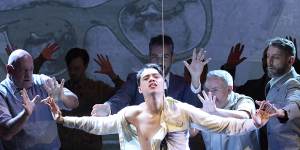
Duncan remains a silent presence throughout in the form of dancer Macon Escobal Riley.Keith Saunders
Composer Joseph Twist’s opera is in the style of a dramatised oratorio in which the chorus takes the major role while solos draw out rough nuggets of individuality. The libretto by Alana Valentine and Christos Tsiolkas is in a documentary narrative style,sharpened uncomfortably by more intimate moments that seize and own the coarsely explicit vulgarity of insults still endured by gay people.
The documentary aspect unfolds like a sequence of news reports of the murder,the “independent” investigation,the legislation,the new witness and the eventual acquittal of long-suspected police officers in 1988.
The story itself does much of the emotional work,leaving each audience member to discover shock,frustration,anger and celebration in their own way. There is an apt inversion of roles in the way Duncan remains a silent presence throughout in the form of dancer Macon Escobal Riley,silhouetted on a rope,leaving a Lost Boy,portrayed by singing actor Tomas Kantor,to tell the story through the eyes of all the anonymous victims of gay hatred.
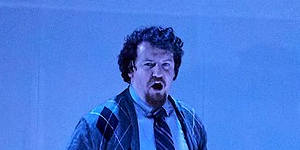
The story itself does much of the emotional work,leaving each audience member to discover shock,frustration,anger and celebration.Keith Saunders
Twist’s score is a sequence of choral and solo numbers,often static and ballad-like,prolonging and intensifying emotionalism in simple melodies and popular styles. For me,music and libretto remained a little estranged.
There was a slight tendency to over-repeat phrases and exaggerate the libretto’s four-line patterns with cadences that fell unceremoniously on the tonic note. Duncan is also portrayed in song with gentle smoothness from Mark Oates,notably where he narrates his awareness of the moment of death in the past tense as though memory has outlasted life.
Oates also sings the role of (former SA) premier Don Dunstan with polished confidence. Kantor plays the Lost Boy with edgy wiriness,singing in show style and belt voice,which sometimes pushes the pitch downwards. It falls to Pelham Andrews to introduce an incisive tone of grinding irascibility in a range of roles,from policeman and politician to lawyer and witness.
Conductor Brett Weymark co-ordinated the Opera Australia Chorus,orchestra and soloists with mellifluous empathy for choral sound. Director Neil Armfield,who commissioned the work in 2022 to mark the 50th anniversary of Duncan’s death,arranged the action neatly around intersecting axes,which Nigel Levings lit with haunting effectiveness.
Ailsa Paterson’s set defines the horizontal plane with a long pool of water as both the physical river and the metaphorical current of life,while Riley’s acrobatic elegance on the rope defines the vertical with evocations of transcendence.
MUSICAL THEATRE
Chicago
Capitol Theatre,until July 28
Reviewed by JOHN SHAND
★★★½
Chicago borrowed two of the most vacuous characters in theatrical history – Velma Kelly and Roxie Hart – and made them razzle-dazzle the world. Simultaneously,its creators,John Kander,Fred Ebb and Bob Fosse,launched a satirical rocket attack on the US justice system that apparently failed to penetrate the large “For Sale” sign.
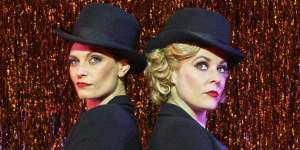
The vacuous characters that razzle-dazzled the world:Velma Kelly (Zoe Ventoura) and Roxie Hart (Lucy Maunder).
Contrary to contemporary mythology,narcissism and a craving for celebrity are not products of our digital age but were there from the time we started speaking rather than grunting. They were certainly thriving in the 1920s when the lure of fame could topple the fear of being hanged in the puny minds of man-killers Velma and Roxie.
Chicago was revolutionary in 1975,and its unique blend of Brecht,Vaudeville,jazz,comedy,sex and rampant immorality holds its lustre to the extent it’s less than six years since the show last hit town. You don’t have to have been around the block too many times to have seen half a dozen productions,all strictly based on Fosse’s original.
The set’s always the same,with the 14-piece band mounted on upstage steps,and the costumes are always black and as slinky – for both sexes – as is legal.
What primarily sets oneChicago apart from another are the performances of those playing Velma,Roxie and Billy Flynn (their celebrity lawyer) and the realisation of Fosse’s choreography. This production doesn’t hold a candle to the 2009 iteration with Sharon Millerchip as Roxie and Caroline O’Connor as Velma,but it does many things very well.
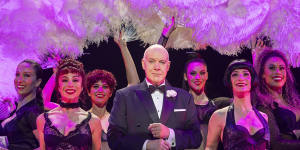
As lawyer Billy Flynn,Anthony Warlow upstages his female co-stars.
It’s the first time I’ve seen someone playing Billy Flynn upstage the women. Anthony Warlow does that effortlessly. Older than most Flynns and looking like a cross between Michael Caine and John Clarke,he oozes debonair charm like a man who’s had great sex for breakfast,followed by a most gratifying appointment with his tailor,and oysters and champagne for lunch. That’s backed up by his voice,a velvety baritone that blows everyone else off the stage as it swoons acrossAll I Care About Is Love andRazzle Dazzle.
Shadowing Warlow in quality is Lucy Maunder as Roxie,who snaps and crackles with the requisite blend of comedic and sexual energy. The problem is that the Roxie/Velma chemistry is pivotal to the show’s success and Zoe Ventoura is a less convincing Velma. Her singing voice is sometimes brittle,her Chicago accent wanders from Illinois to Australia and back,and she simply fails to inhabit Velma as completely as Maunder inhabits Roxie.
The discrepancy is such that if you’d never seenChicago before,you’d leave thinking Roxie was the lead and Velma support. Happily,Ventoura improves markedly in the second act,notably forWhen Velma Takes the Stand,so all is not lost,and the production is amply good enough to ensure we can relish the show’s inherent pizazz.
The ensemble’s execution of the choreography is razor-sharp,although,in terms of sexiness,it’s more safety razor than cut-throat. The band,directed by Anthony Barnhill,is all class,sass and exactitude,and the sound is exceptional.
More pearls are to be found in the minor roles. Asabi Goodman has the barnstorming voice to electrify Mama Morton’sWhen You’re Good to Mama,and Peter Rowsthorn is as good an Amos (Roxie’s beleaguered husband) as I’ve seen,making hisMister Cellophane a genuine highlight. So,even with its flaws,it’s still a hell of a show. Like the US justice system.
MUSIC
Pond
Carriageworks,June 14
Reviewed by JAMES JENNINGS
★★★★
The music of Western Australians Pond splays all over the musical map,from psychedelic rock to funk-infused dance pop. It’s all held together by focal point Nick Allbrook,a frontman who understands the classic-rock-star playbook as defined by the likes of Mick Jagger and the Who.
For more than a sweat-drenched hour the lithe Allbrook strutted,yelped,crowd-surfed,shredded on guitar and twirled his mic cord like he was trying to lasso the band’s oversized energy,only coming in to land for between-song banter that typically consists of an endearing and very Aussie “Thanks heaps!”
Allbrook being a likeable and eminently watchable frontman is only part of the band’s appeal,though:the four other multi-instrumentalist members – Jay Watson,Shiny Joe Ryan,Jamie Terry and James Ireland – are all crack musicians,capable of flitting between genres with aplomb.
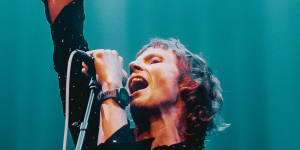
Nick Allbrook is a likeable and eminently watchable frontman.Ruby Boland
Neon River and(I’m) Stung,both taken from the band’s new albumStung,take us to an alternative universe where glam rock is still the hottest sound around,a tequila-ed-up Allbrook prowling the stage like a young Marc Bolan waiting for the confetti cannons to go off at any second.
From there the stylistic pivots come thick and fast:forSweep Me off My Feet,an ecstatic slice of Prince-like R&B-electro-funk-pop,the crowd sings along to one of the best choruses in the Pond catalogue;next comes the vocoder-featuring stoner rock ofBlack Lung.
It’s a sound they heavily lean into onAloneaflameaflower andGiant Tortoise,where the band go full Black Sabbath,laying down riffs heavy enough for several young men in the immediate vicinity to intently head-bang along to.
Proving there’s no lane to which they can’t switch,the band decides the best way to end a show,obviously,is to turn it into a giant dance party.Don’t Look at the Sun or You’ll GoBlind,an extended electro-funk epic,gets the crowd moving,which Allbrook sees as an invitation to throw himself into it,while singing the chorus to the Jacksons’Blame It on the Boogie.
Allbrook marvels several times that this night is the biggest show they’ve ever played – it’s a credit to himself and the rest of the band that they live up to the occasion by performing like it is.
MUSIC
Luke Hemmings
Enmore Theatre,June 13
Reviewed by MILLIE MUROI
★★★½
Since forging a solo career away from Sydney boy band 5 Seconds of Summer,Luke Hemmings has refined his craft and reached new vocal heights.
However,on this night he lacked the star power one might expect from the former lead singer of one of the country’s most successful acts. But he looked at home on stage,and his vocal control and unique timbre entranced us.
“Hi,I’m Luke from Sydney,Australia,” the now Los Angeles-based artist said in a mock American accent. “Somehow that means more tonight.”
Hemmings said songs such asMum,from his debut solo albumWhen Facing the Things We Turn Away From,andGarden,from his most recent albumBoy,were inspired by a longing to return to Sydney. “I wrote these living somewhere else and thinking about here,” he said.
From the melancholyPlace in Me to the rock elements dialled up inDiamonds,both from his 2021 album,Hemmings showcased his versatility.
At points the lighting was overpowering and detracted from one of the key attractions of live performance:seeing the artist,their emotion and moments of connection with the audience.
A cover of the Cure’sFriday I’m in Love injected some energy,while closing songsShakes andI’m Still Your Boy from the latest album capped off a solid performance. Hemmings’ voice doesn’t blow you away with its power,but there’s a refined quality to it that comes through,particularly live.
Whether songs from his 5SOS days no longer align with his creative direction or are unsuited to solos,there was no nod to that pop-rock past,which might have been a nice touch.
Since posting song covers on YouTube in 2011,Hemmings has gone from a kid busking in Hawkesbury,to a band that gained global recognition,and is now an artist who,having found his groove,is polishing his individual style. He may have had more sparkle and star status as part of 5SOS,but going solo has allowed his voice to take centre stage.
The Booklist is a weekly newsletter for book lovers from books editor Jason Steger..